#wizarding history
Explore tagged Tumblr posts
Note
Isn't it a bit funny that we know about the history of Salazar Slytherin more than we know about the history of Godric Gryffindor, the founder of the house that our beloved hero is sorted in? We don't even know if Godric had children or descendants, unlike the other founders of Hogwarts. I'd seriously love to know more about Godric. But Salazar's history and legacy really did fill the audience in more than any other history of the other founders.
Like, what we know about Salazar Slytherin is also questionable. Like, the Founders lived around the 990s, a thousand years before the books. If you ever read early medieval history you know there are a lot of unknowns in the information we have. Ancient authors that wrote histories in which they made shit up, heavily biased information, family genologies where people claim to be descendant of important figures to strengthen their claims even though that connection probably isn't real, people writing thri-hand accounts as if they've been to the even themselves. Historical writing from long enough ago can be a mess (not to mention the lack of standardized spelling and words with meanings lost to time that cannot be translated).
That being said, history in the Wizarding World is weird. We have Helena Ravenclaw and the Bloody Baron at Hogwarts, two people who knew the Founders, who probably spoke Old English (which begs the question of ghosts learning new languages). There might be portraits left behind from these times, which allow a mostly accurate (if filtered through personal bias) view of history. Many of the above problems I mentioned will still exist since you're basing your information on word of mouth and not archeological evidence, but it's way better and more extensive word of mouth than what we muggles can get our hands on.
I know you asked more about the narrative and the fact that the narrative doesn't go much into the founders (especially ones that aren't Slytherin), but I think this question of why JKR wrote one thing over another isn't as interesting as how historical research works in the WW. Since I personally prefer to do Watsonian analysis over Doylist.
Becouse, for JKR, it was probably that the other founders weren't as important to the plot, or not as interesting. Which is a legit reason not to mention them. And, honestly, this is a hole in the world-building I don't mind. It doesn't disrupt the narrative and allows space for headcanons and fanon. Which is good for me. I don't mind when a story leaves some space for the reader to fill in blanks, especially when it's background details like this, which aren't actually all that important. And it's good for stories to leave out some stuff to the readers' imagination — that's part of the fun.
My best guess is that Gryffindor's name died out pretty early like Ravenclaw, who doesn't seem to have any heirs since Helena died. The Smith family are descendants of Hufflepuff. The Gaunts are descendants of Slytherin, but we don't really know about him much more than any of the other founders. Like, we don't even know if the purpose of the Chamber was really to kill muggleborns or if it's an intention that was attributed to him post mortem.
We know in the early Middle Ages the sentiment regarding muggles wasn't as negative as we see later on (after all, witch hunts wasn't a medieval problem, it's an early modern problem):
Shrewd enough to see that their Muggle neighbours would seek to exploit their powers if they knew their full extent, witches and wizards kept themselves to themselves long before the International Statute of Wizarding Secrecy came into effect.
(QTtA)
Early medieval wizards and witches worried over muggles requesting magic from them and exploiting their good nature, not that they would be hunted down. That concern only appeared later in the Renaissance (which is when Beedle the Bard lived, btw). So there is some doubt regarding Slytherins' personal opinions about Muggles, muggleborns, and dark magic (since "Dark Magic" as a term is kinda weird. It's a legal term more than a magical one and most spells that the ministry considers "Dark" aren't so (creating Infri and Horcruxes is dark magic, but a jelli-legs jinx is not actually dark, come on). I mean, the Unforgivables only became such in 1717, so clearly, before then, public opinion was different about them and other curses).
But back to the more interesting question of how historians in the WW work. Like, do they question ghosts? Do they have archaeologists? How do they know what happened in the past? Binns isn't a thousand years old; he lived at least 500 years after the founders, so what is his source for everything about the Chamber?
Well, for this, Quidditch Through the Ages comes in clutch. The book includes an extensive section of the history of Quidditch and explains that wizard historians actually don't work that differently from muggle historians. And that their methods to find out history don't actually involve as many ghost interviews as I would've expected.
Records show that witches and wizards in Europe were using flying broomsticks as early as A.D. 962. A German illuminated manuscript of this period shows three warlocks dismounting from their brooms with looks of exquisite discomfort on their faces. Guthrie Lochrin, a Scottish wizard writing in 1107, spoke of the “splinterfilled buttocks and bulging piles” he suffered after a short broom ride from Montrose to Arbroath. A medieval broomstick on display in the Museum of Quidditch in London gives us an insight into Lochrin’s discomfort (see Fig. A).
(QTtA)
Early wizarding writings and paintings give us some idea of the games our ancestors played. Some of these no longer exist; others have survived or evolved into the sports we know today.
(QTtA)
The famous painting Günther der Gewalttätige ist der Gewinner (“Gunther the Violent Is the Winner”), dated 1105, shows the ancient German game of Stichstock.
(QTtA)
Scotland was the birthplace of what is probably the most dangerous of all broom games – Creaothceann. The game features in a tragic Gaelic poem of the eleventh century, the first verse of which says, in translation
(QTtA)
We owe our knowledge of the rude beginnings of Quidditch to the writings of the witch Gertie Keddle, who lived on the edge of Queerditch Marsh in the eleventh century. Fortunately for us, she kept a diary, now in the Museum of Quidditch in London. The excerpts below have been translated from the badly spelled Saxon of the original. [...] It is immensely interesting that there was a “big Scottish warlock” present. Could he have been a Creaothceann player? Was it his idea to bewitch heavy rocks to zoom dangerously around the pitch, inspired by the boulders used in his native game?
(QTtA)
We find no further mention of the sport played on Queerditch Marsh until a century later, when the wizard Goodwin Kneen took up his quill to write to his Norwegian cousin Olaf.
(QTtA)
These are some examples from the book and the methods for historical research are pretty much the same as we have. It's based on diaries, writing, paintings, and archeological evidence (the medieval broom). No one is asking ghosts who lived back then how Quidditch was played. No one is talking to magical portraits. They rely on physical or written evidence and speculation based on logic, just like we Muggles do.
I mean, magical portraits might have only been invented later, but it doesn't explain why ghosts aren't asked. I mean, Helena and the Bloody Baron were alive in the 10th century. They would be familiar with some of this history; they would know about 10th-century brooms, so how come no one asks ghosts? For that matter, why did no one ask Helena about the whereabouts of Ravenclaw's diadem until Tom Riddle in the 1940s?
And all these questions led me to two new headcanons/theories:
1. Magical portraits were invented in the 1400s or later. The fact that paintings from the early Middle Ages and into the 1100s are referred to as "paintings" and not "portraits" and implied to be non-speaking, suggests the talking portraits we see are a newer magical invention, and therefore history before the early modern period cannot be learned from portraits.
2. Ghosts are considered "unreliable" sources of history. My guess is that most ghosts are more like Binns than they are like Nearly Headless Nick. Binns doesn't know which class he is talking to, what the students' names are, and what year it is. He is stuck in his own unexistence. If most ghosts behave this way, it could explain why it's a frowned-upon practice among magical historians to use their accounts as evidence.
But if that's the case, it's even more bizarre that Binns is teaching history. But then again, teaching history isn't the point of these lessons, and he's been at his post so long, all the parents have been taught by him. Not to mention he isn't teaching his own experience, but that from books, so his own biases/memory issues that are the problem with getting history from ghosts are irrelevant. There would only be a few magical historians (like Bathilda Bagshot) who might object to his position, but most of the wizarding population probably doesn't care.
These are just some thoughts I had regarding how history is written in the WW, and how, therefore, all the in-world history we know is inherently flawed since it is based on surviving written/oral accounts and physical evidence. They clearly don't have any magical method to learn more about their history, and for some reason, no one is asking the ghosts. But this all is great, since it means their history can be taken with a grain of salt the way I usually treat their in-world history.
#harry potter#hp#asks#anonymous#hollowedtheory#hp meta#harry potter meta#wizarding world#hogwarts founder#hollowedheadcanon#hp headcanon#wizarding history#the foudners
68 notes
·
View notes
Note
Muggles don’t have much chances against wizards I believe. Their only advantage is numbers. (That’s why full out war would hurt both wizards and muggles) Wizards have been dealing with Muggles (how to hide from them) for centuries, they must be knowledgeable of muggle technology. They also lived during both muggle wars so they must be aware of the weapons. The fact they managaed to hide their whole community from them for so long and continue managing to do despite increasing muggle technology proves that magic is strong enough and theres probably even magic that serves against nuclear power already.
Canonically, some wizards don’t even know what electricity is or how it works. Arthur is supposed to work in a department dedicated to Muggles, and he doesn’t even know what a rubber duck is for. Throughout the series, it’s implied that wizards live in a parallel reality. If it were established that wizards were interested in Muggles, observing them and keeping up with their advancements, they would obviously have a considerable advantage over them—not only because of magic but also because of their knowledge of Muggles, how their societies operate, and their technology. But as it’s implied, that’s not the case.
The first rule for winning a war is to know your enemy as well as you know yourself, but above all, not to underestimate them, and wizards see Muggles as little more than animals with reasoning. I think Muggles would have quite a few chances because they would take the enemy much more seriously, and the fact that wizards underestimate them would be a big point against them.
Also, Muggles spend their lives fighting wars. The Second Wizarding War is just another Tuesday in the war madness of the Muggles—literally, during the time Voldemort resurged in the ’90s, there were about eight or nine active wars and several in Europe, lol.
#Harry potter#harry potter world#harry potter meta#harry potter headcanons#muggles and wizards#muggles#wizarding society#wizarding world#wizarding history
19 notes
·
View notes
Text
In around 650 A.D wizard familiars as we know them today were created.
Now before this it was not unusual for magic users to keep animals as companions. However as we know a familiar is more than just a simple house cat. Familiars are a representation of your mind, will, and magic.
Now, nowadays wizard familiars are small weaker level creatures of the fey (a lesson for another day). But those of you who know their magical history would know that there was no consistent way for mortals to reach the fey until around 1500 A.D
So how did the first modern interpretation of the Find Familiar spell become created in 650 A.D? The wizards took a play from the Witches handbook.
Witches had, for centuries, find an animal and using magic and witchcraft tame the animal and make it their familiar. The wizards adopted this practice, but because they knew no witchcraft they used magic alone to subdue the animal and bend it to their will.
There were some drawbacks.
1. There was never any guarantee that the animal would be domesticated however they were always gifted higher intelligence. Meaning you could have a super smart wild animal that may or may not be bound to your will.
2. They could also die, like permanently. And then you’d have to do the whole process over again. Plus they were real animals
3. Finally they were real animals. The needed to be fed, given clean water, and go to the bathroom. Fine if you have an animal that is native to where you are and can hunt for itself, harder if you’ve taken it to the middle of nowhere. And although the animals would be smart enough to be potty trained, they were also smart enough to go in your house on purpose.
Because of this get a familiar used to be very high level magic. This of course changed in around 1530 AD when Find Familiar was created.
#wizards#wizarding history#notes from my class#find familiar#familiars#occult#fantasy#fantasy but make it fact#in character
5 notes
·
View notes
Text
Dream by the Fire by GallifreyisBurning Pairing: Harry/Draco Rating: M Word Count: 11k Podfic available here Read by: acGranger Length: 1-2 hours When Draco Malfoy resurfaces in England after eight years abroad—tattooed, pierced, and wanting to take over a corner of Harry's coffee shop to work on a writing project—Harry can't help but be intrigued. Where has he been? What is he working on? Why here? And why does he have to look so stupidly hot with all those tattoos? find the full podfic library here
#drarry#drarry fic rec#drarry podfic#hp fic rec#harry/draco#draco/harry#hp podfic#hp podfic rec#rating: m#10 to 25k words#fluff#christmas#hp christmas fic#get together#coffee shop au#writer au#writer draco malfoy#barista harry potter#barista au#theme: tattoos#magical theory#wizarding history#enemies to friends to lovers#post hogwarts#post second wizarding war#mlm ship
5 notes
·
View notes
Text
I understand why a lot of fantasy settings with Ambiguously Catholic organised religions go the old "the Church officially forbids magic while practising it in secret in order to monopolise its power" route, but it's almost a shame because the reality of the situation was much funnier.
Like, yes, a lot of Catholic clergy during the Middle Ages did practice magic in secret, but they weren't keeping it secret as some sort of sinister top-down conspiracy to deny magic to the Common People: they were mostly keeping it secret from their own superiors. It wasn't one of those "well, it's okay when we do it" deals: the Church very much did not want its local priests doing wizard shit. We have official records of local priests being disciplined for getting caught doing wizard shit. And the preponderance of evidence is that most of them would take their lumps, promise to stop doing wizard shit, then go right back to doing wizard shit.
It turns out that if you give a bunch of dudes education, literacy, and a lot of time on their hands, some non-zero percentage of them are going to decide to be wizards, no matter how hard you try to stop them from being wizards.
70K notes
·
View notes
Text
Episode Two coming soon!
Follow us on Tiktok and Youtube @pensieveproject

#harry potter#harry potter sims 4#sims#harry potter sims#youtube#the sims 4#wizardingworld#harry potter machinima#the pensieve project#sims 4 machinima#sims 4 harry potter#hogwarts legacy#wizarding world#philosophers stone#sims 4 storytelling#bbc drama vibes#fantasy machinima#harry potter fan series#hogwarts#dursleys#sims 4 custom content#sims 4 cc#sims machinima#magic in the sims#wizarding history#hp machinima#docu-drama machinima
1 note
·
View note
Text
Feeling horny 💦🍆who is down for fun 🤭😋, Reblog if you love trans girls, let talk further on my telegram handle: @Officialisabellaasmansu
#asexual pride#asian lgbtq dramas#bi pride#black lgbt#dead gay wizards#gay#gay ai#gay art#gay couple#gay guy#trans beauty#trans woman#trans community#mtf trans#happy pride 🌈#igbtq pride#lgbt#gay love#lgbt history#lgbtlove#trans pride#trans gamer#trans gay#transgender#pride month#pride 2025#bisexual pride#lesbian pride
1K notes
·
View notes
Text

Regulus stumbling out of the Potter's fireplace, trembling to his core, two years after Sirius did. Two years.
aka a timeline in which Regulus managed to get away before it was too late
And isn't it funny that both heirs of the Noble House of Black ended up in the same place, in the same state (traumatized✨), both falling in the arms of their brother. Such happy lives they have :)
I thought I wasn't gonna be an angst account but I very obviously was lying to myself (but hey, that scene's the beginning of better days, isn't it?)
#sirius is here for regulus the same way james has been here for him#regulus needed that hug#history has a way of repeating itself#i was listening to lullabies while drawing this if you wanna know#dead gay wizards#marauders#marauders era#slytherin skittles#regulus black#sirius black#james potter#exoras draws
2K notes
·
View notes
Text
About Hogwarts Castle's Architecture
I think the history is wrong... Like, stone castles only became a thing in Britain when the Normans brought the practice over with them from France (Norman rule was officially established in 1066). And the first stone castles in Scotland were only built around the 1100s. Hogwarts was built around the 990s... so what's up with that?
(Like, there were some fortified stone structures in Scotland pre-normans (brochs), but no one would really call them a typical castle. Also, they were built in the Iron Age (Brochs were specifically built between 400 BC and 200 AD), so not the founders' times)
Also, many of the architectural details of Hogwarts in the movies/Hogwarts Legacy/any other video games/illustrations have much later influences, what with the Gothic architecture (which only came around in the 1200s) and elements from Victorian restored castles (I'll go more about what this means later).
And I have a Watsonian theory/headcanon to make it make sense.
What I think, is that the Hogwarts castle we (and the characters) experience, has been heavily reconstructed over the past thousand years. So Hogwarts likely started as a simpler, wooden structure (as was common in Scotland around the 10th century) and it changed and grew and evolved throughout the centuries.
So we'll walk through the history of castle architecture in Scotland and explain how Hogwats evolved over the years. (Becouse I'm an architecture and history nerd, sue me).
Pre Founders
Hogwarts is legend to have been built where the founders found a pensive:
The Hogwarts Pensieve is made of ornately carved stone and is engraved with modified Saxon runes, which mark it as an artefact of immense antiquity that pre-dates the creation of the school. One (unsubstantiated) legend says that the founders discovered the Pensieve half-buried in the ground on the very spot where they decided to erect their school.
(Pottermore)
So, the location probably wasn't empty, but had some evidence of past wizarding residence there. How much is unclear, but it was a place magic was practiced in before the founders.
990s
Hogwarts is founded as a school and sanctuary. Muggles at the time didn't really believe in witchcraft (the church considers believing in witchcraft heresy). So, it's not really to protect themselves together, but more to allow wizards to build a united community.
There is an element of hiding magic from muggles:
Why didn’t we choose to produce flying barrels, flying armchairs, flying bathtubs – why brooms? Shrewd enough to see that their Muggle neighbours would seek to exploit their powers if they knew their full extent, witches and wizards kept themselves to themselves long before the International Statute of Wizarding Secrecy came into effect.
(Quidditch Through the Ages)
But it's not for the same reason as the later witch hunts. At this time, people who confessed to witchcraft would need to repent (not via execution, mind) because they'd be seen as delusional. After all, magic doesn't exist according to church doctrine at the time. and as mentioned in the book, the concern was to be bothered to help muggles with everything, not because they were hunted at the time.
Around this time there is the magical government in England at least, is the Wizard Council, also known as the Wizengamot. Due to the similar name, the muggle Wittengamot (the council of lords that chose the king of England) might be aware of their wizard equivalent, but they might also be completely unaware (explained in the next section).
Castles, in this time period in the UK, looked something like this:
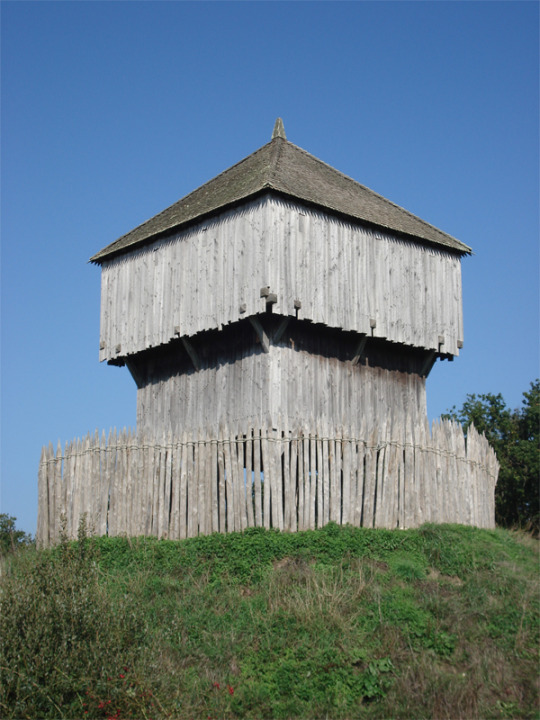

Hogwarts, when founded, probably looked like this combination of buildings and not what we imagine as a castle.
with the Chamber of Secrets as a basement. It's canon that a Gaunt later added the pipe entrance from the bathroom, so it's original entrance lay elsewhere.
Note that this means it wasn't the founders who but the Common Rooms, Room of Requirement, or the moving staircases and that the in-universe history books are wrong.
Since Hogsmeade was founded by Hengist of Woodcroft who was a student of Helga Hufflepuff when she was alive, the village was probably founded in the century following the school's founding.
1000s-1100s
Here we get the Norman Conquest of England, and while Scotland wasn't Norman, the culture in Scotland was influenced by the changes down south. Specifically, castle architecture is something they copied from the Normans.
The reason I mentioned earlier the muggle Witengamot might've not been aware of the wizarding community is because we know William brought with him wizards in his army, like the Malfoys:
Like many other progenitors of noble English families, the wizard Armand Malfoy arrived in Britain with William the Conqueror as part of the invading Norman army. Having rendered unknown, shady (and almost certainly magical) services to King William I, Malfoy was given a prime piece of land in Wiltshire, seized from local landowners, upon which his descendants have lived for ten consecutive centuries.
(Pottermore)
But many other pureblood wizard family names we can date back to the Norman invasion. Such as: Lestrange, Peverell, Wealey, Gaunt, etc. So, it's somewhat implied William won England with the help of wizards that the local Anglo-Saxon English didn't have fighting with them.
Due to these Norman wizards clearly getting positions of influence in the wizarding community (talked a bit more about this here[]), it's likely they or even William himself wanted to improve Hogwarts to keep the wizardibg population onside.
So, around the later 1000s or early 1100 Hogwarts would've looked something like this:



So, basically, the same structure as before, but the keep (where the Great Hall is, is built from stone. The Great Hall (AKA the most defensible place in the castle everyone fell back to in the Battle of Hogwarts) was the first built.
As for the inside:


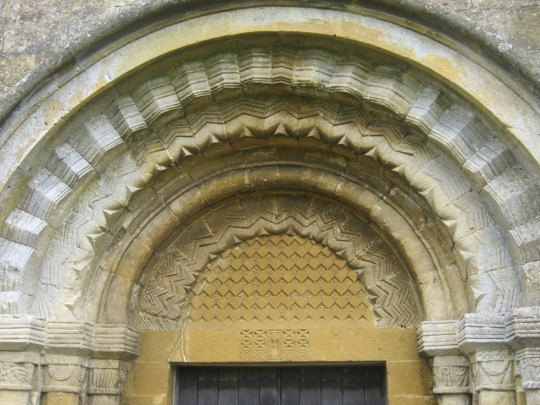
We have geometric details on the columns and archways (which are round, it's not yet the pointed gothic arches we all know and love). The walls would all be painted white and then colorful and vibrant colors over it (somewhat visible in the picture on the left).
1200s-1300s
Throughout the next two centuries, more and more wings would be added to the castle. Many of the classrooms and dorms that were outside the keep in the outer buildings moved to these new wings inside the main stone castle. The outer walls & fortifications would also be improved and extended from the former ones and a proper gatehouse would likely be built:
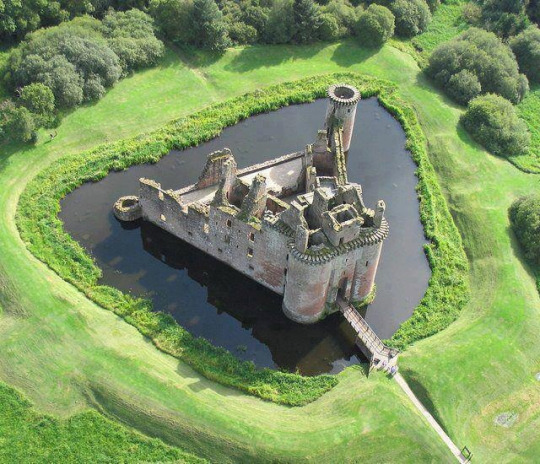

And a few churches, since they tended to be more decorated on the outside and I want to explain this is when gothic architecture was a thing and that most of the styles we recognize for castles are from this period:



This is when the Room of Requirement, the moving staircases, the towers (the Astronomy Tower, the Headmaster's Tower, and perhaps the Owlery), and the various common rooms would be built.
(Note the castle on the left would've likely had a whitewash on all of the exterior back in the day)
At this point, the Great Hall, and the quad if we think of the typical Hogwarts castle would be built:

(Image from Hogwarts Legacy)
There would be no transfiguration courtyard area yet and no clocktower yet as they are likely later additions.
I'd also note the inside of the castle, would look something like this at this point:
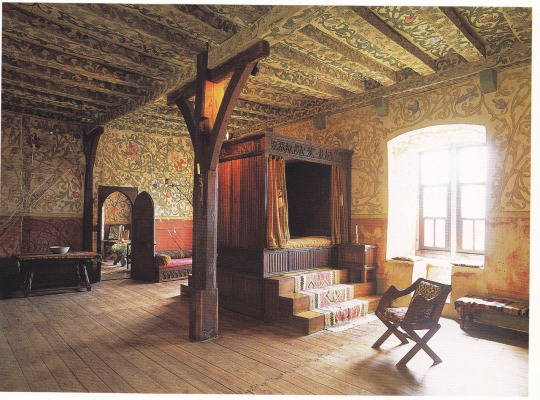


The walls would be painted and colorful and vibrant. You might also see wall hangings like we see in the Gryffindor Common room in the movies, that's actually accurate (the wall tapestry/curtain things, not the furniture, the furniture is 17th and 18th century) except the stone would likely not be bear stone and instead have a whitewash over it and tapestries over the whitewashed stone. Bear stone wasn't an all that common look in this era unless they used pretty stones that were meant to be shown off (which was expensive, hence rare).
1500s-1600s
This period is still building in a style called Gothic (12th to 16th century), but we're adding more intricate detail, and the style for furniture changes quite drastically (because we've entered the Tudor area). I believe that around the 1500s and the 1600s, more wings were added, like the clocktower, the transfiguration courtyard, and the viaduct (a bridge was probably there before, but I think it was rebuilt with the new building):

The style of buildings we're looking at now would have this sort of exterior:
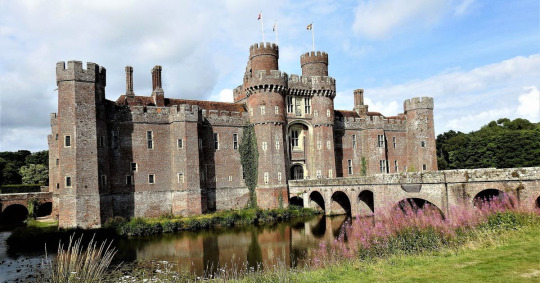
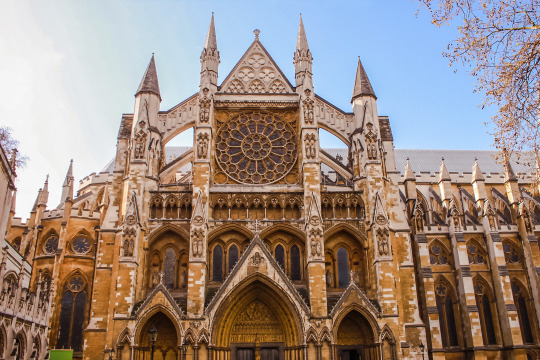

(Note the house on the left and castle on the white would've likely had a whitewash on all of the exterior back in the day)
And this is the interior we're talking about:
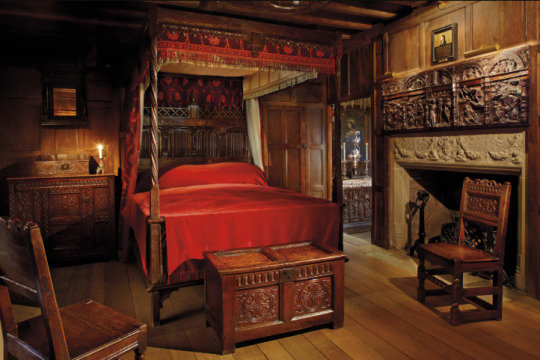
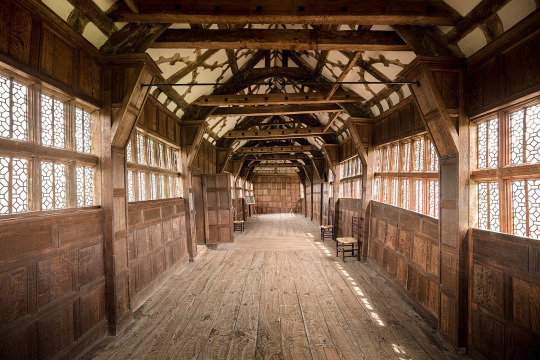
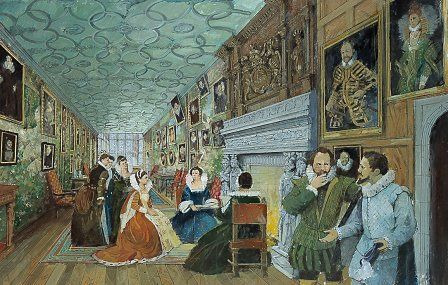
Also, up until this point, greenhouses weren't really a thing (at least not the glasshouse variety). I assume there was an Herbology Garden or that perhaps a Vegetable Patch Harry mentions exists next to the greenhouses and served as the place where they grew plants because glasshouses like we think of when we read the word "greenhouse" were only started being built in England late in the 16th century. So the Greenhouses are likely a 17th-century addition since the wizards probably adopted them a little later than the muggles.
1700s
This is when indoor plumbing was introduced to Hogwarts and the entrance to the Chamber of Secrets was changed:
When first created, the Chamber was accessed through a concealed trapdoor and a series of magical tunnels. However, when Hogwarts’ plumbing became more elaborate in the eighteenth century (this was a rare instance of wizards copying Muggles, because hitherto they simply relieved themselves wherever they stood, and vanished the evidence), the entrance to the Chamber was threatened, being located on the site of a proposed bathroom. The presence in school at the time of a student called Corvinus Gaunt – direct descendant of Slytherin, and antecedent of Tom Riddle – explains how the simple trapdoor was secretly protected, so that those who knew how could still access the entrance to the Chamber even after newfangled plumbing had been placed on top of it.
(Pottermore)
1800s
Now, back to what I mentioned in the opening paragraph about Victorian castle reconstruction. So, during the Victorian era, many rich people bought castles to restore and preserve them. Victorians in England were kinda obsessed with the Medieval period (and Ancient Egypt, but we're not talking about that right now) so they wanted to be able to walk around castles, and they had a lot of castles in the UK that fell into disrepair and just stood there empty. The thing is, the Victorian people who restored castles had no idea what Medieval castles actually looked like in the Medieval period. So all the castles you see with this sort of interior (which are most reconstructed castles, btw):
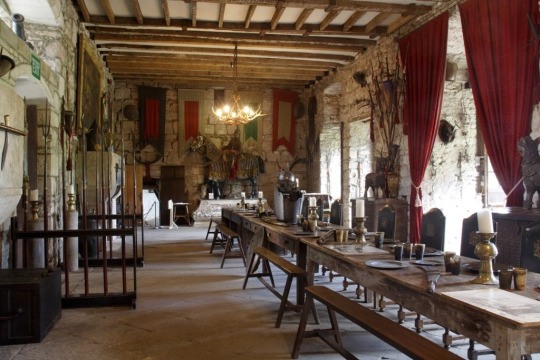
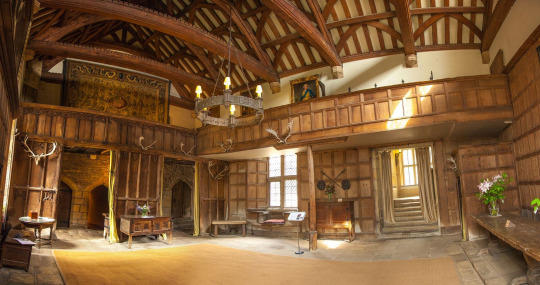
That's a Victorian reconstruction. They built how they imagined medieval castles looked like according to their own tastes and aesthetics and what they saw from more recent Todur castles, not how medieval castles actually looked like.
That being said, Hogwarts was continuously used throughout all these years, so I imagine some of these Victorian elements would make their way in, but not to the same level as these reconstructions.
Basically, different locations in the castle would look different depending on when they were built. Most furniture is likely to have been replaced more recently and would at most date back to the 1500s. So, we'll see a lot of dark wood furniture that isn't painted the way they would've painted furniture in the medieval period.
I'd also expect that some of the older walls/ceilings are still painted very vibrantly (which fits with the wizard's sense of style overall).
Basically, I think the Hogwarts we experienced in the books wasn't built in one year as a monolith by the founders. It was added to over time. Rooms that look older Medieval, and ones that look like a Tudor addition would all exist within the same castle. Areas in the older sections would have 18th-century wooden paneling because reconstruction was needed. I personally think that's the right way to go about designing Hogwarts since most castles in Britain are like that (and in the rest of Europe).
Castles changed and grew according to the needs of whoever lived there at the time and the technology available. And since, well, at some point castles weren't needed as fortified structures anymore, they lost fortifications for aesthetics. We have no surviving castles that actually look the way they did back when they were built. All the preserved ones had wings added, walls paneled with wood, and the windows replaced. And in many of them, you can actually see the patchwork in the bricks, the window style changing from one window to the next across a single wall. I think that's part of what makes castles gorgeous and it always made sense to me Hogwarts was like that too.
#harry potter#hp#hp meta#hollowedtheory#harry potter meta#wizarding world#hogwarts#hogwarts school of witchcraft and wizardry#hogwarts castle#wizarding world of harry potter#hollowedheadcanon#hp headcanon#hollowed hp redesign#historical context#wizarding history
90 notes
·
View notes
Text
Nerdy loser Remus Lupin who somehow became best friends with the three most popular guys at Hogwarts, only to learn that they are also losers
#loser remus lupin#history nerd remus lupin#loser bf remus lupin#remus lupin#james potter#sirius black#peter pettigrew#marauders#marauders era#the marauders#dead gay wizards#dead gay wizards from the 70s#remus lupin headcanon#remus lupin hc#marauders headcanon#wolfstar#remus x sirius#sirius x remus
2K notes
·
View notes
Text
A Gift of True Esteem by apliddell Pairing: Harry/Draco Rating: E Word Count: 53k Podfic available here Read by: Cailynwrites, ETL_Echo_Audiobooks Length: 5-6 hours Professor Draco Malfoy believes he has something unique to bring to Hogwarts' History of Magic course. Professor Harry Potter is willing to be convinced.
#drarry#drarry fic rec#hp fic rec#drarry podfic#drarry podfic rec#hp podfic rec#hp podfic#professor au#theme: coming out#werewolf au#werewolf draco malfoy#post hogwarts#post second wizarding war#pining#trans character#queer character#queer harry potter#gay character#gay draco malfoy#enemies to friends to lovers#coworkers#get together#theme: chronic illness#wizarding culture#wizarding history#fluff#theme: redemption#theme: poetry#professor harry potter#professor draco malfoy
10 notes
·
View notes
Text
"Historical" tabletop RPGs will be like "this game is based on rigorous historical research of medieval Western European society, and while it does have wizards, they're informed by authentic, period-accurate beliefs about how magic worked", and I'll be like "are the wizards really based on medieval Western European beliefs about magic, or is it a bunch of 1970s Neopagan 'ancient witch cult' stuff in a funny hat", and the game will be like "those are the same thing".
2K notes
·
View notes
Text
I've looped around from finding the belief that The Wizard of Oz was "the first color film" or "first technicolor film" understandable if wrong to finding it deeply annoying
Like. I get how it feels true - how the transition from sepia to technicolor in the film feels epochal, and how it's a springboard to people imagining how AMAZING and how AWESTRUCK audiences must've been at the time, but it just isn't the case, and no one in 1939 would've thought it was the first color film.
I mean, you've probably seen Snow White (1937) and Adventures of Robin Hood (1938). At the time color features were becoming more common, and they had been common in cartoons and shorts for years.
On a base level, if The Wizard of Oz was such a monumental moment in film history, giving people something they've never seen before, why did it only break even at the box office? By all accounts while not a flop it did decently but not great, and it only became a Cherished Classic thanks to TV airings later on. I mean, 1939 saw what is still, if adjusted for inflation, the highest grossing film ever made, and it wasn't The Wizard of Oz
Here is the actual history of color: most silent films were tinted, most commonly with different scenes being all tinted different colors, but more rarely hand-coloring. But back then people started experimenting with many different "true" color film systems, most of which failed for one reason or another, and there were a couple silent features made in two-strip technicolor, which had a more limited palette. At the start of the sound era, some black & white scenes would have color segments; this stage has been largely forgotten bc in many cases, the color segments don't survive & we only have them in black and white. Then three-strip technicolor began and became the dominant form of color until the late 1950s, with the first full-length three-strip technicolor film being 1935's classic...Becky Sharp. Which did decently, and got one Oscar nom for Best Actress, but didn't really become a classic. And then color films became more common until they became the norm in the 1960s
But it has to be a classic, right? It can't just be some random movie that ushered in technicolor. It has to be a famous movie everyone's heard of. It can't have been a gradual process touched by many individual artists, it has to be something one Great Man ushered in overnight, and the crowds were amazed, bc they had just been waiting for someone to Do Color Film so they could ditch black & white forever. It couldn't have been the case that they rejected many previous attempts at color film bc they sucked. Nothing can ever be the result of many people making many choices in many works of art, it has to be the work of one Great Work of Art that Changed Everything Instantly, and all the little people and failed experiments and less-enduring ones just have to be erased to make way
But it isn't. The transition from sepia to color in The Wizard of Oz did dazzle audiences, and still does, but that's because it's a incredibly well-done visual effect and a creative choice within the story to show the change from Kansas to Oz. We don't have to say it was important bc it was the first to do something technologically; it can be important for just being a really good movie
1K notes
·
View notes
Text
regulus following potter family traditions: beautiful, life changing, soul healing
James following the black family traditions around romance that haven't been done in generations, the ones regulus has always dreamed of:

#look the black family had good traditions at some point#regulus doesnt hate his family name he just hates what its been turned into the the last few generations#they surely couldnt have been bad all the way through history#jegulus#jegulus fluff#starchaser#sunseeker#sun seeker#star chaser#marauders#dead gay wizards from the 70s#marauders era#regulus black#james potter#james potter x regulus black#james x regulus#🌊💀 + 🛋️🦌#🌊💀#🛋️🦌
462 notes
·
View notes
Text
jaster mereel had to die young because the moment he ever had to meet palpatine on his home turf he'd take one look at the politician's eclectic collection and immediately go 'oh !! Is that a ceremonial sacrificial dagger of darth rabies???" and immediately go off on a tangent about old republic lore while palpatine gets bodied by at least five jedi in the background
#star wars#chaotic oc hours#jaster mereel#i love fandoms interpretion of him being such a history nut#whats a jedi to a sith? whats a sith to a mandalorian nerd?#i might.be in writers block hell but i can still slowly rotate characters like a rotisserie chicken#i think jaster would know a lot about sith and start rambling but as soon as he makes eye contact with a jedi hes 'sith bad very bad no like#jaster daydreaming about the good ol days (sith and jedi in armor being cool badasses)#hed prob kidnap a sentinel just because they wear armor#he wants to interrogate- i mean investigate very scientifically and methodically about the jedi armor crafting styles#do you think mandos dont quite understand the diffeeence between sith and jedi in this day and age?#space wizard with laserswords all look the same when youre flying by on a jetpack#ok i need sleep
620 notes
·
View notes
Note
I read your post on the canonical likelihood that the Wizarding World follows Christianity rather than paganism commonly seen in 'pureblood culture' or political fics, so I kind of had a question?
There's the whole mess of God and the church against witchcraft (such as the banning of Harry Potter books), so how would that affect Christianity in the WW? Additionally (considering how many fics use it as rationale for pureblood bigotry), how do you think a pureblood culture fic would pan out around Christianity?
Hello 👋
I think I talked about this in the past here, but what we see with the anti-witchcraft sentiment in churches is relatively modern. Like, until the 1600s, incidentally, when the Statute of Secrecy became a thing, witch hunts and witch burnings weren't common. Until the latter half of the 1200s the Catholic church considered believing in witchcraft heresy and even after they started viewing witchcraft as devil work, they used witchcraft allegations to prosecute the Knight Templars in the 1300s and protestants in the 1400s, not actual witches. It was politics back then more than actual fear of witchcraft which we only start seeing late in the 1500s. But let's, take a look at witch hunts in history and see why the WW, who broke off from the muggle one in the late 1600s probably didn't really have a problem with Christianity (at least in the UK, the US, and other parts of the Europe are very different. The UK was actually not that big on the witch hunts compared to the rest of Europe).
Past entries in my 'wizards aren't pagan essays': part 1, part 2, part 3, part 4 (has the most quote evidence)
Witch Hunts Timeline:
(Many items on the list are taken from here)
~910 - The canon "Episcopi," a text of medieval canon law, was recorded. It condemned maleficium (bad-doing) and sorilegium (fortune-telling), but it argued that most stories of these acts were fantasy. It also argued that those who believed they could somehow magically fly were suffering from delusions. This text influenced later catholic church canon.
1154 - John of Salisbury wrote of his skepticism about the reality of witches riding in the night.
1230s - An Inquisition against heresy was established by the Roman Catholic Church. (Not against witches, against people who speak heresy)
1258 - The pope accepted sorcery and communication with demons as a kind of heresy, and therefore prosecutable by the church.
1306-1315 - The Church moved to eliminate the Knights Templar. Among the charges were heresy, witchcraft, and devil-worship.
1316-1334 - The pope issued several bills identifying sorcery with heresy and pacts with the devil.
1317 - In France, a bishop was executed for using witchcraft in an attempt to kill Pope John XXII. This was one of several assassination plots around that time against the pope or a king. (AKA accusations of witchcraft being about politics and not about magic).
1340s - The Black Death.
1401 - Parliament passed the Suppression of Heresy Act, the first English law authorizing the burning of unrepentant or reoffending heretics. With the intention to burn protestants translating the bible to English, not witches.
1484 - Pope Innocent VIII authorized two German monks to investigate accusations of witchcraft as heresy, threatening those who interfered with their work. (AKA accusations of witchcraft being about politics and not about magic. Again).
1486 - The "Malleus Maleficarum" (basically the witch hunters' bible, written by a dude who had nothing to do with the church) was published.
1492 - Nearly Headless Nick was beheaded, supposedly for witchcraft. I will note it's odd since witches/wizards were commonly hanged in Britain. Additionally, a priest actually came to comfort him in his cell prior to his execution on the block and he didn't even have a trial at all. So, his death wasn't really a proper witch trial as the first Witch Act in England was only passed in 1542, so he was executed before Witchcraft could have been legally tried in England and something more complicated happened there. My bet — politics that he doesn't like talking about.
1500-1560 - A period as one in which witchcraft trials, and Protestantism, were rising in Europe (These things were connected since the catholic church saw protestants as basically witches and burned/hanged them as well).
1542 - English law made witchcraft a secular crime with the Witchcraft Act.
1552 - Ivan IV of Russia issued the Decree of 1552, declaring witch trials were to be civil matters rather than church matters.
1560s-1570s - A wave of witch hunts was launched in southern Germany. The witch hunts really started in Europe as civil law trials, not church prosecution.
1563 - The second English Witchcraft Act was passed in England. Again, treating it as a civil offense, not a religious one.
1580-1650 - Considered the period with the largest number of witchcraft cases in Europe. Most cases of witch hunts in the UK though, happened in the 1640s, and the worst of it lasted only 14 months.
1682 - Mary Trembles and Susannah Edward were hanged, the last documented witch hangings in England itself.
1689 - The Statute of Secrecy was signed.
1692 - Salem witch trials took place in the British colony of Massachusetts.
1692 - The Statute of Secrecy went into effect.
1717 - The last English trial for witchcraft was held; the defendant was acquitted.
1736 - The English Witchcraft Act was repealed, formally ending witch hunts and trials. (Most of Europe only officially ended witch hunts later).
So we can see that the actual witch hunts (trials and burnings) were a secular civil matter and that church law wasn't really a part of it. For most of the medieval period, believing in witchcraft would have been seen as heresy, and even into the 1400s the church was more concerned with prosecuting protestants and political opponents than witches (which many clergymen still doubted the existence of) — because they saw them as the real danger. Basically, the witch hunts weren't a religious medieval thing as they are often portrayed, but a Renaissance civil movement for the most part. (In Europe, at least, the witch hunts in the American colonies are a whole other beast that operated diffrently).
In England, the laws regarding witchcraft were civil laws made by parliament, not by the church. And the witch hunts in England were shorter (in time period they took place over) than most other Western countries (France, Germany, and the US, for example, had longer witch hunt periods, more anti-witch laws, and a higher death toll to these hunts). So it makes sense the wizards in the UK wouldn't really see anything contradictory between being Christian and being witches/wizards since the prosecution didn't come from the church. It came from their muggle neighbors:
The persecution of witches and wizards was gathering pace all over Europe in the early fifteenth century. Many in the magical community felt, and with good reason, that offering to cast a spell on the Muggle-next-door’s sickly pig was tantamount to volunteering to fetch the firewood for one’s own funeral pyre. “Let the Muggles manage without us!” was the cry, as the wizards drew further and further apart from their non-magical brethren.
(Albus Dumbledore on “The Wizard and the Hopping Pot”, Tales of Beedle the Bard)
The wizards' disdain wasn't for the church or Christianity but for the muggles in the homes next to them. That's who betrayed them and hunted them down, not the church. This is why we see the kind of anti-muggle sentiment we see. Becouse wizards' neighbors, muggles whom they helped and lived beside for generations turned on them. For the WW, the hunter wasn't the church, it was the muggle next door.
And if we look at the numbers of accused witches killed, the UK and Ireland were on the lower estimates in Europe:
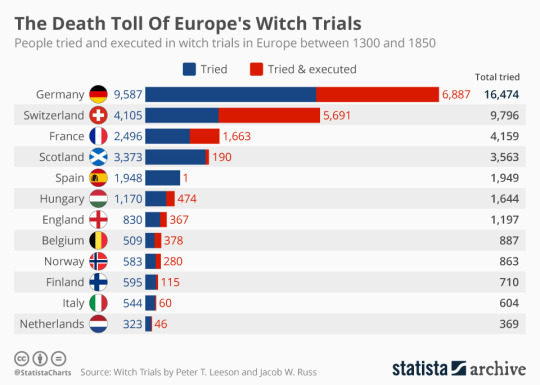
Scotland acquitted almost all tired witches and while England killed more, the number of trials and executions was much lower than in Germany, Switzerland, and France. Even though Belgium and Norway had fewer trials, they killed more of the witches tried than England by percentage. Ireland isn't even on this list but their numbers are even lower. (Spain is low on the witch executions since the Inquisition was more concerned with religious opponents and heretics than witches):
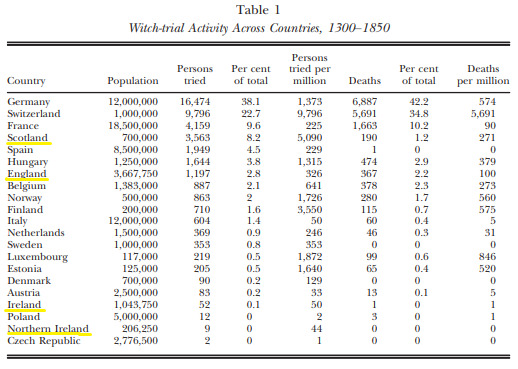
(Source - a book about the economic and religious background to the witch hunts, for anyone curious. I will note I've seen higher estimates of the death toll of the witch hunts, but these higher estimates are often not based on existing historical records so it's hard to know the real number of deaths)
This context about how the witch hunts were worse in central Europe explains why Durmstrang and Beauxbatons are so secretive about their location compared to Hogwarts. It also gives context to why Grindlewald had more supporters from these areas and why even Voldemort had supporters from Durmstrang (Karkaroff and Dolohove maybe) even if they have nothing to do with Britain — the anti-muggle sentiment is just more widespread there because the witch hunts were worse there ("There" being the Holy Roman Empire). I think this gives interesting context to the world-building.
As for the second part of your ask:
Religion in pureblood society
This part has more of my headcanons sprinkled in and isn't strictly canon, but here's how I see it.
We don't really see them going to church on Sundays or even on holidays. In general, church-going isn't one of the traditions they adhere to. If it was, we would've likely seen a small chapel at Hogwarts, but there isn't one.
That makes a lot of sense. The reformation of the church happened in the early 1530s (it's a little more complex because Mary tried to return catholicism but I'm not going into that), hence before wizards broke away from muggle culture, so most wizards we see (Ones from the UK at least, as I assume the Irish ones (not north Ireland) are still mostly catholic) are what I call Magical Anglican. They are Anglican but with a magical flare and some unique wizard saints.
As Anglicans are protestants, their doctrine is more focused on the Bible than the church. So the average Magical Anglican wizard in the UK probably steps foot in a church only on rare occasions and mostly practices the traditions and holidays without a church involved. We see a wizard priest conduct weddings and funerals outside, wherever the wizards are, so clearly it's not about the church for them. It's about the community.
That being said, I think certain communities, such as Godric's Hallow, do go to church on holidays. In DH, when Harry and Hermione notice a sermon for Christmas at the church in Godric's Hallow, I headcanon many of the wizards living there were in the church that night.
In general, they seem to celebrate all the Christian holidays and have their own traditions for them. Like, the Christmas hats on the house elves' heads at Grimmauld Place. Like, I headcanon that's something Sirius' family did when he was a kid and even before that. I mean, why else would they have little house elf Christmas hats for all the mounted heads just sitting there ready?
Their decorations have a magical flare, and so do their holiday traditions, but they're mostly the same. Yes, their Christmas crackers are magical, but Christmas crackers are a thing in Britain. Yes, they place gnomes or fairies atop the Christmas tree, but it still is a tree topper that serves the same purpose. Yes, their carols are a little different, but they are still Christmas carols that mention god.
I like to headcanon godparents are pretty common in the WW, and that Magical Anglicans baptize infants pretty regularly. I mean, everyone in universe treats being a godparent like a big deal, and something important they respect. So, culturally, I believe purebloods christian their kids and that most wizards have godparents. I headcanon said godparents are usually relatives.
Like, I headcanon Alphard (Sirius' uncle who left him money) was Sirius' godfather. I like to headcanon Cygnus and Druella were Regulus' godparents. I also like to headcanon Uncle Billius, from whom Ron got his middle name from Ron's godfather. Sirius was Harry's godfather as a the brother-from-another-mother he was for James.
Purebloods might hold Yule Balls like we see in GOF, but, like in the book, it has nothing to do with the pagan holiday and more to do with just a cool wintery theme for the ball.
I can totally see some purebloods (I think not all purebloods are actually upper class) having fancy dinner parties for holidays too. Like, that seems to me like something they'd do besides balls. Like, I want to be a fly on the wall in my headcanoned Black family Christmas dinner with all the cousins and aunts and uncles when Sirius was 11. Just, imagine it.
So, while they aren't regular church-goers, I think you can see the footprint of Christianity all over their culture.
I mean, Hogwarts doesn't have a church, but they serve pork in meals on the regular in the Great Hall, something Jewish or Muslim wizards would not eat if they followed their religions' rules. The calendar Hogwarts operates by is one that follows Christian holidays like Christmas and Easter. They don't work/study on Sunday, which is a Christian thing. In Muslim countries, Friday is the holiday day, while in Israel, it's Saturday. Even these little things that seem obvious are based in Christianity. Yes, it's the case in Britain, but if wizarding culture was separate enough to have a different religion, I doubt they would've kept all these little footprints of Christianity in their society.
The way I see it, they're Christian in faith and ideals, but have some of their own magical spins on the traditions and holidays. They are more focused on their community than going to Church (which might be a result of the muggle communities they lived in turning on them). So, that's kinda how I see religion in the WW.
(Obviously, this is different in different areas even in the UK, and could vary from family to family. This is more the general vibes I got and some headcanons).
#harry potter#hp#hp meta#asks#anonymous#hollowedtheory#harry potter meta#wizarding world#wizarding society#wizarding religion#hp headcanon#hollowedheadcanon#historical context#witch hunts#wizarding history
54 notes
·
View notes